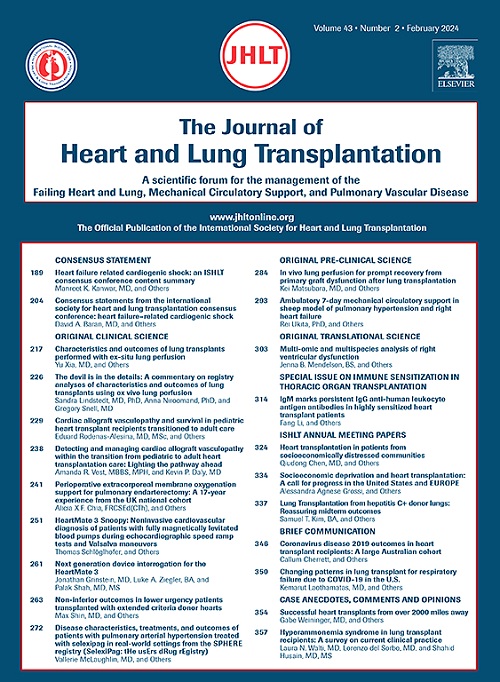柏林之心 EXCOR® 主动驾驶汽车在北美的首次体验。
IF 6.4
1区 医学
Q1 CARDIAC & CARDIOVASCULAR SYSTEMS
引用次数: 0
摘要
对于使用心室辅助装置(VAD)的较小儿童患者,柏林心脏 EXCOR® 仍是主要的持久支持方式。它需要与外部 IKUS 连接,其便携性和电池寿命有限。新型 EXCOR® Active 移动驱动装置的电池寿命长达 13 小时。我们介绍了 EXCOR® Active 在北美首次用于使用柏林之心设备的儿童患者的经验。我们进行了回顾性病历审查。在 2022 年 10 月至 2024 年 3 月期间,有七名患者使用了柏林之心,并得到了 EXCOR® Active 的支持。所有患者最初都使用 IKUS 支持,过渡到 EXCOR® Active 的中位时间为 12.0 天(IQR 9.5,18.5),使用 EXCOR® Active 支持的中位时间为 65.0 天(IQR 32.0,81.0)。EXCOR® Active 不存在重大安全问题,操作问题也极少。从 IKUS 过渡到 EXCOR® Active 后,病人和护理人员在医院内的移动性增加了。使用 EXCOR® Active 有可能提高等待心脏移植的儿童患者的生活质量。本文章由计算机程序翻译,如有差异,请以英文原文为准。
First North American experience with the Berlin Heart EXCOR Active driver
For smaller pediatric patients on ventricular assist devices, the Berlin Heart EXCOR remains the main form of durable support. It requires a connection to the external IKUS, which has limited portability and battery life. The new EXCOR Active mobile driving unit has a battery life of up to 13 hours. We describe the first North American experience with the EXCOR Active in pediatric patients with a Berlin Heart device. A retrospective chart review was undertaken. Between October 2022 and March 2024, 7 patients were on a Berlin Heart and supported with the EXCOR Active. All patients were initially supported with the IKUS with a median time to transition to the EXCOR Active of 12.0 days (interquartile range [IQR] 9.5, 18.5) and a median time of support with the EXCOR Active of 65.0 days (IQR, 32.0, 81.0). The EXCOR Active posed no significant safety issues, and minimal operating issues were noted. Following the transition from IKUS to the EXCOR Active, there was increased patient and caregiver mobility throughout the hospital. Use of the EXCOR Active has the potential to improve the quality of life in pediatric patients waiting for heart transplantation.
求助全文
通过发布文献求助,成功后即可免费获取论文全文。
去求助
来源期刊
CiteScore
10.10
自引率
6.70%
发文量
1667
审稿时长
69 days
期刊介绍:
The Journal of Heart and Lung Transplantation, the official publication of the International Society for Heart and Lung Transplantation, brings readers essential scholarly and timely information in the field of cardio-pulmonary transplantation, mechanical and biological support of the failing heart, advanced lung disease (including pulmonary vascular disease) and cell replacement therapy. Importantly, the journal also serves as a medium of communication of pre-clinical sciences in all these rapidly expanding areas.

 求助内容:
求助内容: 应助结果提醒方式:
应助结果提醒方式:


